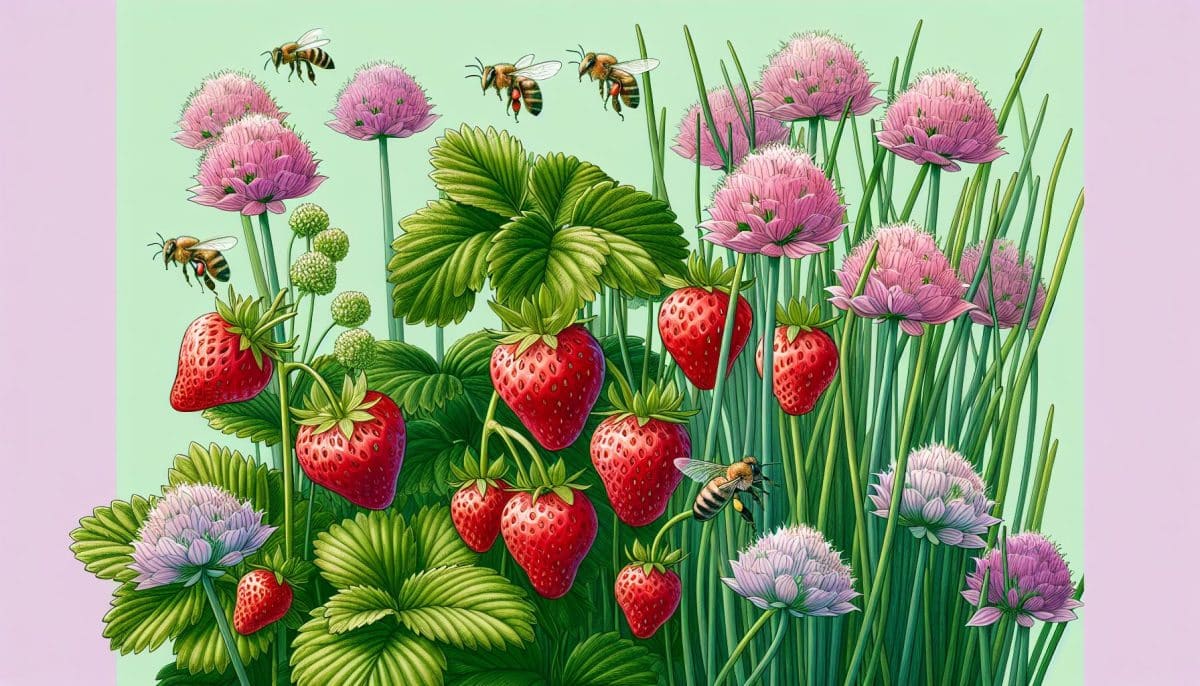
Growing strawberries successfully means more than just planting and watering. It’s about creating a thriving ecosystem right in your garden. Companion planting is a natural way to enhance your strawberries’ health and yield. By pairing them with the right neighbours, you’ll not only boost their growth but also deter pests and diseases. Let’s jump into the best companion plants for your strawberries and why they’re the perfect match for your berry patch.
Benefits of Companion Planting for Strawberries
Companion planting offers a multitude of benefits for your strawberry patch, from pest reduction to improved growth. By implementing this strategy, you’re laying the groundwork for a healthier and more productive garden.
Pest Control is one of the most significant advantages of companion planting. Certain plants emit natural chemicals or fragrances that repel strawberry pests, minimising the need for chemical pesticides. For example, marigolds release a substance that deters nematodes, while borage is known to ward off strawberry-eating insects.
Nutrient Sharing occurs when companion plants contribute to the soil composition beneficially. Beans and peas fix nitrogen in the soil, which strawberries can then utilise for better growth and fruit production. This symbiotic relationship ensures that your strawberries have access to essential nutrients.
Weed Suppression is another critical benefit, as companion plants like buckwheat grow quickly, shading the soil and preventing weeds from taking over. This not only saves you time from weeding but also ensures that your strawberries are not competing for resources.
Improved Pollination happens as companion plants attract pollinators, resulting in better fruit set for strawberries. Flowers like lavender and sage draw bees, which are crucial for strawberry flower pollination.
Optimal Use of Space makes the most of your gardening area. By combining plants with different heights and growth patterns, you can maximise yield within a smaller footprint.
| Benefit | Companion Plant | Real-Life Impact |
|---|---|---|
| Pest Control | Marigolds, Borage | Decreased nematode and insect presence |
| Nutrient Sharing | Beans, Peas | Enhanced soil nitrogen for strawberry uptake |
| Weed Suppression | Buckwheat | Reduced weed growth and maintenance |
| Improved Pollination | Lavender, Sage | Increased bees in the garden improving pollination |
| Optimal Use of Space | Various | Higher yield in limited space |
Incorporating these companion plants not only supports your strawberry growth but also promotes a sustainable approach to gardening. You’ll enjoy the richness of nature’s solutions offering tangible results in your own backyard.
Factors to Consider When Choosing Companion Plants

When you’re planning to enhance your strawberry patch with companion plants, it’s crucial to assess several factors that will dictate the effectiveness and harmony of your garden. Understanding these dynamics will enable you to make informed decisions, ensuring your strawberries and their companions thrive together.
Light Requirements
Companion plants must have similar sunlight needs to your strawberries. Since strawberries flourish in full sun, select companions that also prosper in bright conditions. Plants with disparate light needs can lead to competition or one overshadowing the other, hindering growth.
Soil Preferences
Strawberries prefer well-drained, slightly acidic soil with a pH between 5.5 and 6.8. You’ll want to pair them with plants that can tolerate or thrive in similar soil conditions.
Root Structure
Complementary root systems foster good coexistence. Shallow-rooted herbs can live alongside the deeper roots of strawberry plants, ensuring they don’t compete for nutrients and water. Mature Size
Size matters in companion planting. You don’t want larger plants to smother your strawberries. Opt for companions that grow to a similar height to prevent shading and competition for light.
Growin Seasons
Synchronising the growing periods of strawberries with companion plants prevents any conflict in cultivation times. It’s best to pair your strawberries with plants that have overlapping productive periods to enhance pollination and growth cycles.
Watering Needs
Consistent watering patterns are vital for strawberries, and pairing them with plants that have significantly different moisture requirements could be detrimental. Choose companion plants that need a similar amount of water to maintain balance in the garden ecosystem.
By carefully considering these key factors, your garden will not only be a hub of growth and productivity but also a testament to a well-planned symbiotic environment where each plant benefits from the other’s presence.
Best Companion Plants for Strawberries
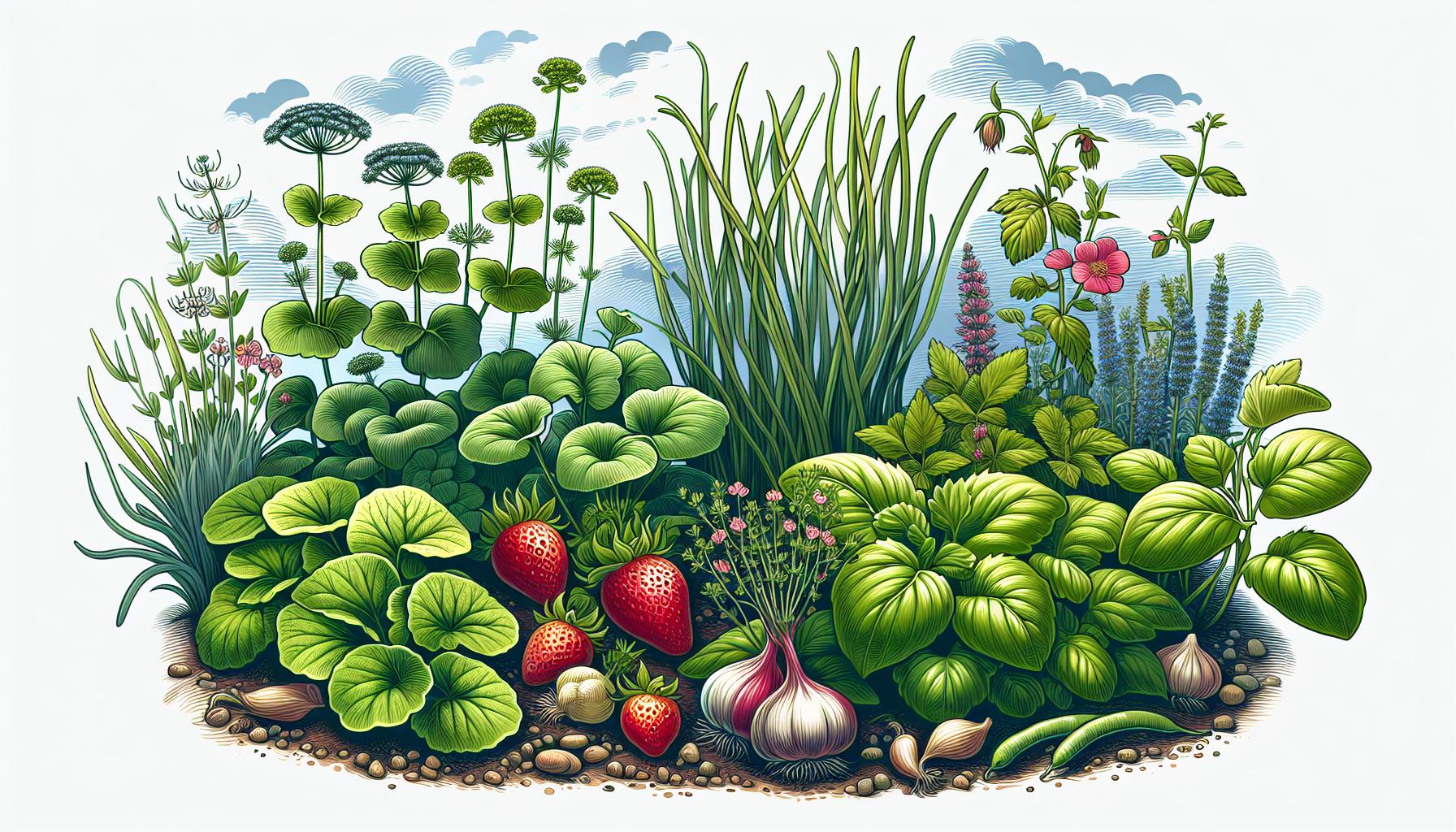
When you’re looking to bolster your strawberry patch, several companion plants stand out due to their beneficial interactions. Borage is a powerhouse, attracting pollinators and deterring pests, while Bush Beans improve soil nitrogen levels, fostering a richer growing medium for your strawberries. Beyond these, you might consider including:
- Spinach: This leafy green thrives alongside strawberries, sharing space without competition.
- Thyme: With its ability to repel worms that target strawberry plants, thyme serves as a protector and a fragrant ground cover.
Getting into specifics, Onions and Garlic work wonders in repelling aphids, which are common strawberry pests. Here’s a quick glance at what to pair with your strawberries:
| Companion Plant | Benefit to Strawberries |
|---|---|
| Borage | Attracts pollinators |
| Bush Beans | Enhances soil nitrogen |
| Spinach | Coexists without space conflict |
| Thyme | Repels harmful worms |
| Onions | Deters aphids |
| Garlic | Deters aphids and fungi |
Real-life examples show that gardeners who plant garlic near their strawberries observe markedly fewer instances of fungal diseases, along with reduced aphid activity. These aren’t isolated incidents; they are backed by a garden’s natural ecosystem, where every plant has a role in supporting the others. In essence, the strategic placement of these companions not only promotes a healthy strawberry crop but also fosters a self-sustaining garden environment.
1. Borage
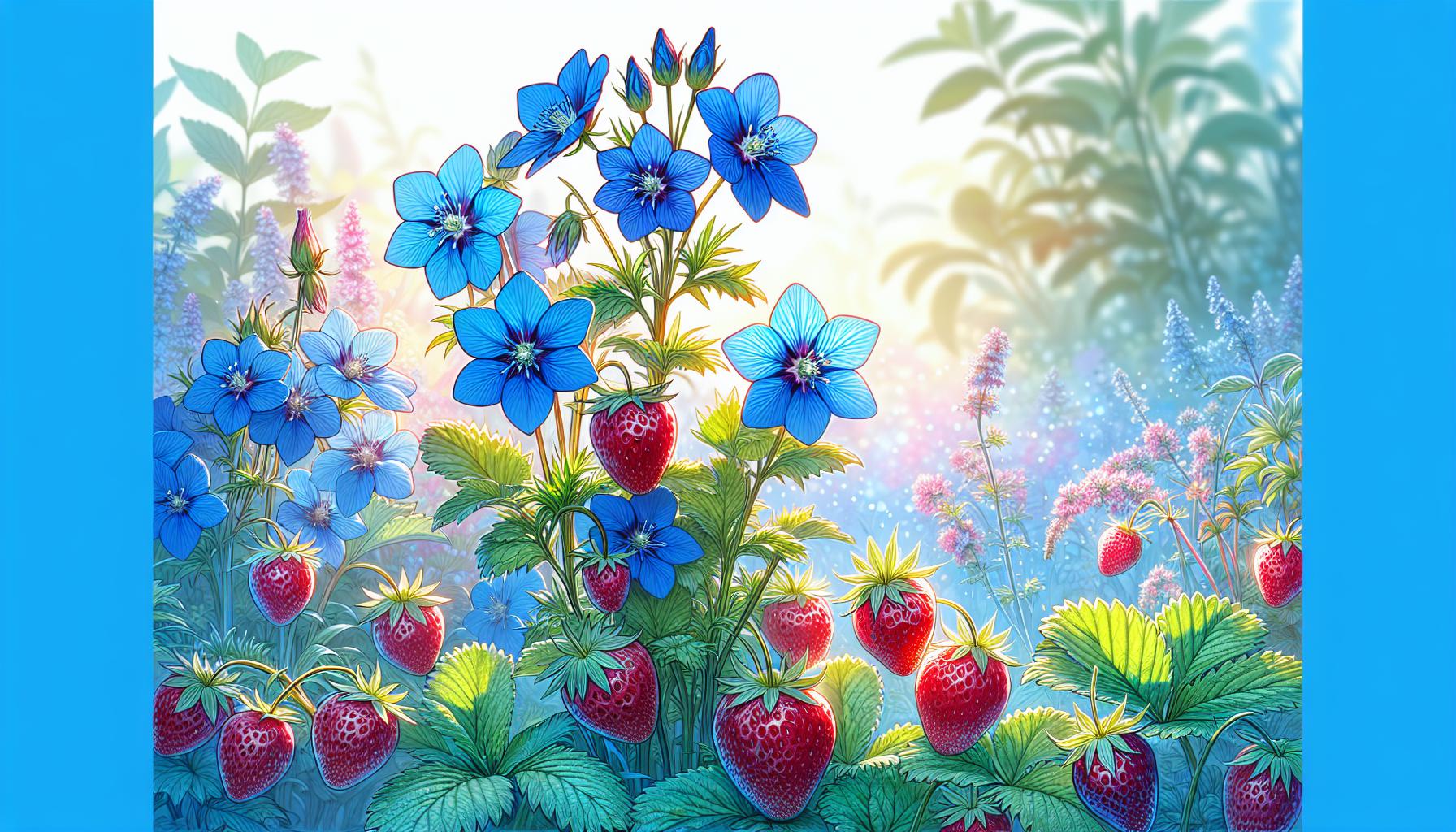
Borage, with its vibrant blue flowers and fuzzy leaves, isn’t just a pretty face in your garden. Considered one of the Top Companion Plants for strawberries, borage offers myriad advantages. When planted alongside strawberries, borage operates as a power-packed companion that you’ll want to know more about.
Key Benefits of Borage:
- Attracts pollinators like bees which are essential for strawberry plant fertilization.
- Acts as a natural pest deterrent, reducing the need for chemical pesticides.
- Improves soil condition and nutrient availability through its deep taproot system, which is beneficial for shallow-rooted strawberry plants.
An example of borage’s effectiveness can be seen in organic strawberry farms where synthetic chemical usage is minimal. These farms often report Lesser Pest Attacks and Higher Berry Yields. Also, borage contributes to the strength and taste of strawberries, a fact attributed by many gardeners to the nourishing root interactions of borage that augment the soil’s fertility.
Adding borage to your strawberry patch doesn’t just boost the strawberries; it also introduces a Useful Culinary Herb to your repertoire, as borage leaves and flowers are edible with a light cucumber flavour. A British community garden noticed that after integrating borage, their strawberries were more robust and the community members enjoyed using the borage in summer drinks and salads, adding a nutritional and economic benefit.
Remember to plant your borage in early spring after the last frost, giving it time to establish itself before your strawberries start fruiting. Aim for a healthy balance in your garden and watch as your strawberry plants thrive alongside their floral ally, borage.
2. Thyme
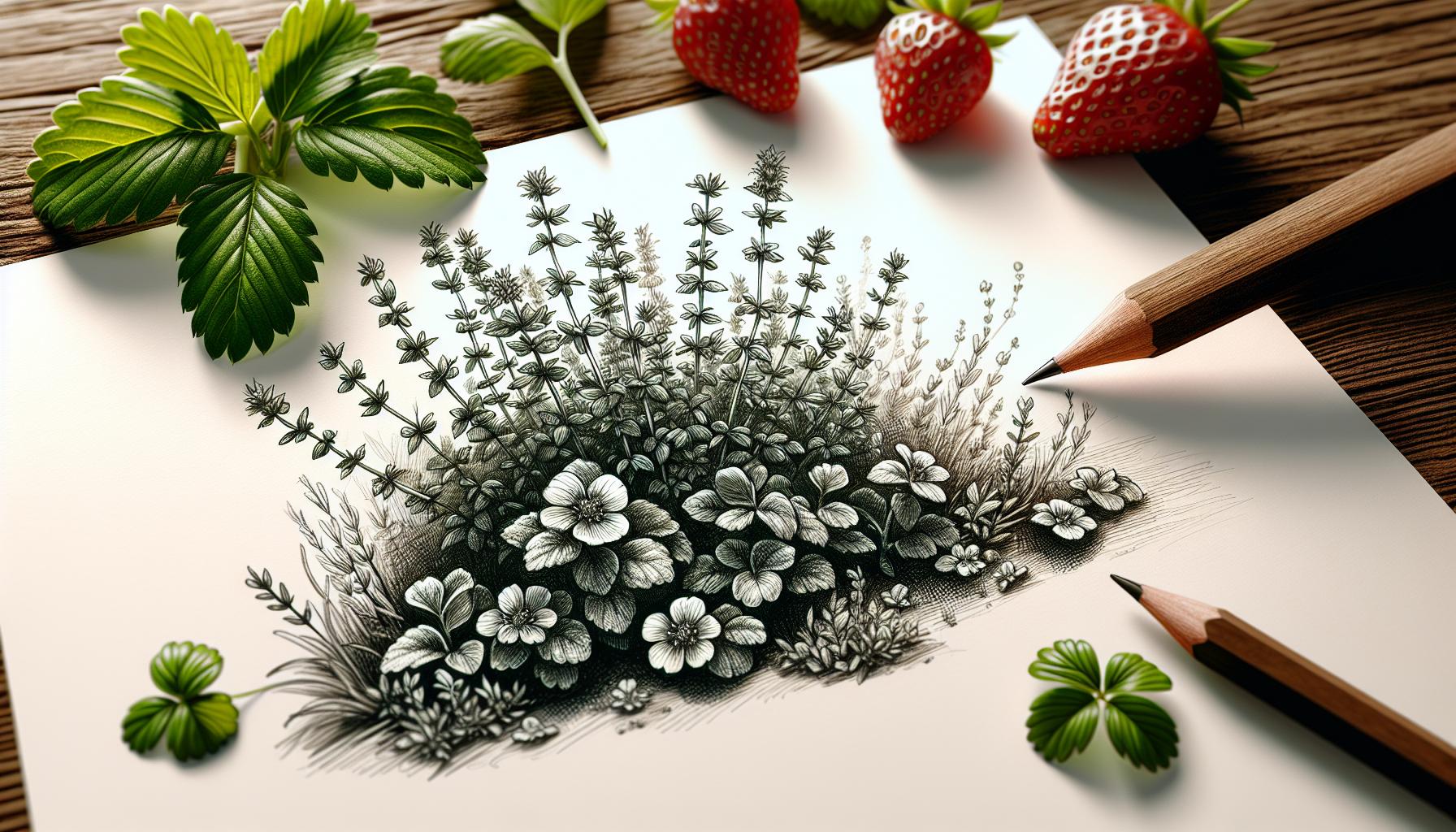
Planting thyme near your strawberries can dramatically enhance your garden’s ecosystem. Thyme’s strong aroma reputedly wards off many strawberry pests, which can mean fewer chemical pesticides and healthier plants. Allowing thyme to intermingle with your strawberry plants isn’t just about pest control—it also attracts beneficial insects such as hoverflies and predatory wasps. These natural predators help maintain the balance by feasting on aphids and other pests that can wreak havoc on your strawberries.
Besides its pest-controlling properties, thyme enriches the strawberry patch by acting as a ground cover. This herb competes with weeds, reducing the need for frequent weeding sessions. Its low-growing, drought-resistant nature makes it an ideal choice for gardens aiming for water efficiency.
Research shows that incorporating thyme in companion planting schemes results in healthier strawberry plants. A study in the Journal of Agriculture and Ecology Research International observed that strawberry crops surrounded by thyme had a significant decrease in common strawberry diseases, specifically grey mould, also known as Botrytis cinerea.
- Pest repellent: Naturally deters common strawberry pests.
- Attracts beneficial insects: Helps control pest populations.
- Ground cover: Competes with weeds and promotes water efficiency.
- Disease reduction: Linked with lower incidences of grey mould in strawberries.
When it comes to planting, it’s straightforward—the best time to plant thyme is in the spring, alongside your strawberries. You’ll notice it’s a hardy plant that requires minimal care once established and it thrives in full sunlight, just like strawberries. With thyme’s low maintenance needs and perennial nature, you’ll have a steadfast companion for your strawberries year after year.
3. Marigold
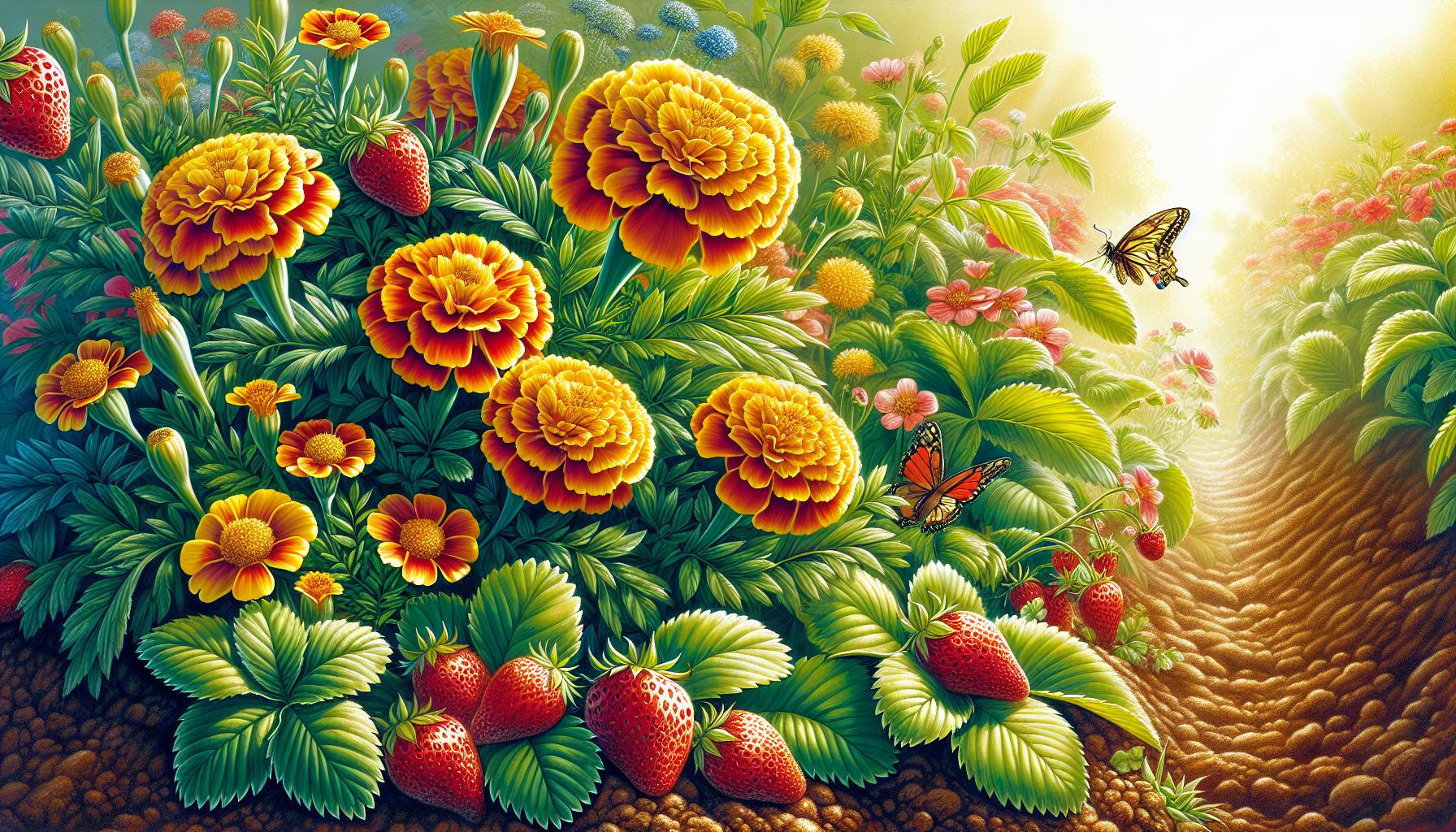
Integrating marigolds into your strawberry gardens boosts overall plant health and vitality. These vibrant flowers aren’t just a feast for the eyes; they’re powerhouses when it comes to companion planting.
Pest Control
Marigolds have a unique ability to repel unwanted pests. Their pungent scent is known to deter aphids and rabbits, two common nuisances for strawberry plants. You’ll often find that planting marigolds nearby significantly reduces the pest population without the need for chemical insecticides.
Soil Health
Roots of marigold plants excrete a substance that is toxic to nematodes – microscopic worms that attack the roots of strawberry plants. By including marigolds in your garden, you’re essentially setting up a natural barrier against these harmful pests.
Attract Beneficial Insects
While marigolds keep certain pests at bay, they also attract pollinators like bees and beneficial insects such as ladybirds. These insects contribute to a more productive strawberry patch by improving pollination rates and preying on harmful pests.
Aesthetics and Practicality
Beyond their utility, marigolds add a splash of colour between your strawberry rows. They are hearty flowers that handle varied conditions well, making them an excellent choice for gardeners of all experience levels.
Remember, to get the best results, plant your marigolds in full sun alongside your strawberries, as they thrive in similar conditions and require similar care. With marigolds as your chosen companion plant, your strawberries will be healthier and more robust, while your garden will be more vibrant and diverse.
4. Nasturtium

Nasturtiums offer striking rewards when planted with your strawberry crop. Beyond their vibrant blooms and peppery leaves, they serve a critical role. Nasturtium acts as a trap crop, luring aphids and other pests away from your strawberries. This ensures your strawberry plants remain healthy and undamaged by these common garden nuisances.
Also, nasturtiums possess a unique ability to improve the flavour of strawberries. The spicy-sweet aroma of the flowers is believed to infuse into the berries, enhancing their natural sweetness. Gardens with both strawberries and nasturtiums often yield fruit that’s exceptionally tasty.
Here’s where it gets even more interesting – nasturtiums also promote vigorous growth in strawberries. They have the capability to introduce airborne compounds that strawberries can benefit from, ensuring your strawberries grow plump and are well-nourished.
- Acts as a trap crop for aphids
- Enhances strawberry flavour
- Promotes vigorous growth in strawberries
Considering nasturtiums is easy to grow and maintain; they’re an excellent addition for both novice and experienced gardeners. Make sure to plant them in full sun or partial shade, and you’ll see the symbiotic relationship between these plants flourish. Nasturtiums will cascade beautifully over your garden spaces, providing not just functional benefits but also adding aesthetic appeal.
5. Chives

When you’re looking to bolster your strawberry plants’ resistance to pests and diseases, chives are an ideal companion. These versatile herbs offer a multitude of benefits for your strawberry patch.
Chives, with their sharp aroma, naturally repel many garden pests, an attribute backed by both anecdotal and scientific evidence. Their strong scent is a deterrent to unwanted visitors like aphids and mites which might otherwise feast on your strawberries. Studies have shown that chives can also prevent fungal infections, such as powdery mildew, due to their antifungal properties, thereby making them a low-maintenance option for organic gardeners.
Not only are chives beneficial for strawberry plants, but they also contribute to the ecosystem of your garden. Flowering chives attract pollinators like bees, which are essential for the fertilisation of strawberry flowers. This cross-attraction helps to ensure a larger and more bountiful harvest of strawberries.
Another notable benefit of chives is their ability to enhance the taste of strawberries. The proximity of chives is thought to contribute subtle flavour notes to the strawberries, providing you with a tastier crop.
Summarizing, incorporating chives into your strawberry garden is straightforward. They’re perennials and require minimal care. Planting chives around the borders of your strawberry beds not only maximizes your garden’s productivity but also contributes to the overall health and flavour of your strawberries. Ensure that the chives get ample sunlight and occasional watering to thrive alongside your fruit-bearing companions.
Conclusion
Embracing the art of companion planting is a savvy move for your strawberry patch. With chives as your ally, you’ll fend off pests and invite beneficial pollinators leading to a bountiful strawberry yield. The added perk of potentially tastier strawberries is a delightful bonus. So why not plant some chives and watch your garden thrive? Your strawberries—and your taste buds—will thank you.
Colin Macmillan is a seasoned entrepreneur and the CEO of Riverwood Landscape, a leading landscaping company based in Canada. He has been at the helm of the company since leaving high school, demonstrating his strong leadership skills and business acumen.
Colin’s expertise lies in various aspects of landscaping, including lawn care, interlocking, sod installation, and commercial maintenance. His hands-on approach and dedication to the craft have been instrumental in building Riverwood Landscape into a reputable brand.
One of his most notable achievements is the creation of a successful landscape franchise that services multiple locations. This accomplishment underscores his strategic thinking and ability to scale operations effectively.
Colin has also had the privilege of working with Guelph Hospital for landscaping and maintenance, a testament to the trust and reliability that his company has earned over the years.
His professional mission is to offer the best services and experiences for customers, a goal that he tirelessly pursues. Colin’s commitment to excellence and customer satisfaction continues to drive the growth and success of Riverwood Landscape.








